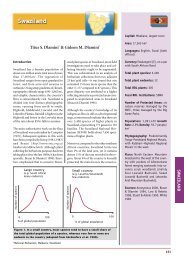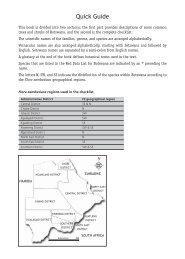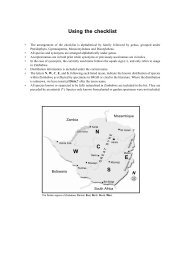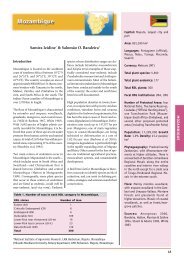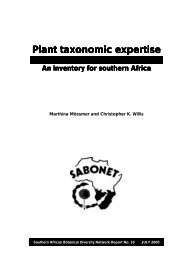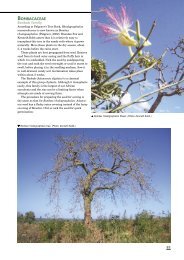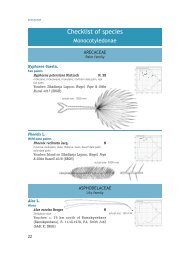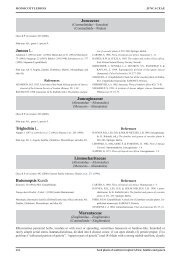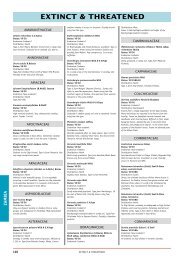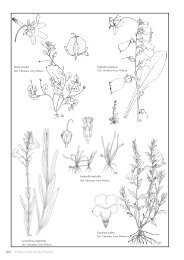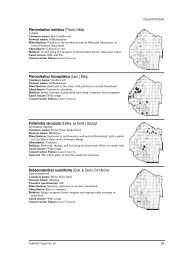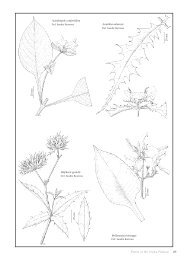141-172 - SABONET
141-172 - SABONET
141-172 - SABONET
Create successful ePaper yourself
Turn your PDF publications into a flip-book with our unique Google optimized e-Paper software.
the families of Cyperaceae-like plants (Juncaceae,<br />
Eriocaulaceae—here spelled Eriocaulonaceae—<br />
and Poaceae) plus keys to and illustrations of the<br />
Namibian species of Juncus and Eriocaulon.<br />
The authors are to be congratulated on tackling<br />
such a daunting task. As noted in the introduction,<br />
this is only the first step towards a well-researched<br />
Flora. Much more taxonomic and nomenclatural<br />
research—especially tracking down of type specimens—has<br />
to be done before that goal is achieved.<br />
Although the present publication is designed for<br />
use in the field and by non-specialists, with simplified<br />
terminology, it should encourage people to<br />
collect and identify material and to build up the<br />
specimen base in WIND.<br />
On paging through the book I came across a few<br />
glitches and inconsistencies which are perhaps<br />
forgivable as it was produced in a fairly short time.<br />
For example, Dinter 7599 is listed as Cyperus<br />
foliaceus, a tropical species. In Podlech Dinter<br />
7599 is cited as C. tenuispica and the duplicate in<br />
PRE is definitely that species. To sort this out<br />
sheets at M, PRE and WIND would need to be<br />
compared. And that is only one of the 168 listed<br />
species! There is a strange and incorrect reference<br />
to Rendle (Bibliography p. 90). It is a pity that the<br />
list of species (Appendix 1, pp. 91–96) is based on<br />
the published version of PRECIS, which is severely<br />
outdated, while an electronic version is<br />
available which is continuously updated. Unfortunately<br />
the genus Monandrus Vorster—still unpublished<br />
from Vorster’s 1978 D.Sc. thesis—has been<br />
included here. These problems aside, it is a useful<br />
book to have and I look forward to trying the keys<br />
on Namibian material.<br />
World Economic Plants: a standard reference.<br />
Wiersema, J.H. & León, B. 1999. CRC Press,<br />
Boca Raton, Florida. ISBN 0-8493-2119-0. 749 pp.<br />
Hard cover. 286 x 220 mm. Price US$125-00.<br />
This authoritative work includes nearly 10 000<br />
entries on vascular plant taxa which are considered<br />
to be of economic importance. The first and major<br />
part of the book (pp. 1–536) is a Catalogue of<br />
these plants, listed alphabetically by genus, species,<br />
and, where applicable, infraspecific name;<br />
<strong>SABONET</strong> News Vol. 4 No. 2 August 1999<br />
cultivars are excluded.<br />
A big plus is that the<br />
catalogue is very easy<br />
to use, with large font<br />
size and doublecolumned<br />
text contributing<br />
to legibility,<br />
while abbreviations<br />
used are obvious ones<br />
and do not require<br />
paging back to the<br />
beginning for explanations.<br />
It is easy to find<br />
the entry for a particular taxon as the genus,<br />
species and infraspecific names are in bold, with<br />
the genus name, where it first occurs, in bold<br />
capitals. Individual entries comprise the currently<br />
accepted name of the taxon (including author<br />
names) on the first line. The following line lists<br />
synonyms, if any, in italics, then on the next line<br />
multilingual common names are listed, with the<br />
preferred one underlined. The next line details the<br />
economic importance of the plant, with the final<br />
line briefly listing world-wide distribution.<br />
The second part is a comprehensive Index of<br />
Common Names (pp. 537–749) relating to the<br />
entries in the Catalogue.<br />
The authors, Drs Wiersema and León, are plant<br />
taxonomists employed by the Agricultural Research<br />
Service of the United States Department of<br />
Agriculture (USDA-ARS). Their compilation is<br />
based on many critically evaluated sources, which<br />
are freely acknowledged. The book had its beginnings<br />
in “A checklist of names for 3 000 vascular<br />
plants of economic importance”, first published<br />
1977 by Dr. E.A. Terrell, to whom the present<br />
volume is dedicated. Many other publications<br />
were consulted, as well as plant specialists worldwide.<br />
Various criteria used for inclusion are<br />
explained in the Introduction, but for me the most<br />
noteworthy factor is the global nature of the data.<br />
The information published here is an extract of a<br />
much larger database accessible on the World<br />
Wide Web at http://www.ars-grin.gov/npgs/tax/<br />
taxecon.html. (For more information on the web<br />
site, see From the Web in this issue.)<br />
145



